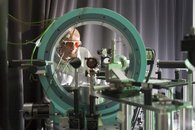Knowing the elastic properties of geo-materials is crucial to determine the mineralogical composition of the Earth's interior. The Brillouin scattering lab at the Helmholtz Centre Potsdam GFZ enables us to determine the velocities of sound waves in minerals, glasses and fluids to pressures of the deep Earth. We use Brillouin scattering - the inelastic scattering of laser light by thermal atomic vibrations (phonons) in the samples under investigation. We measure the frequency shift of the scattered light which is related to the speed of sound in the sample material as a function of pressure, temperature and orientation inside the sample. From these data we are able to determine the full elastic tensor which controls the elastic response of a material subject to a mechanical action. This corresponds, for instance, to the periodic deformation caused in rocks by seismic waves propagating through them.
Fig.: Our Brillouin spectroscopy system at GFZ Potsdam is designed to host large experimental setups
Brillouin scattering laboratory in PETRA III
We have built, in collaboration with DESY HASYLAB, a new Brillouin spectroscopy system at PETRA III, the third generation synchrotron source in Hamburg. The new systems allows one to combine acoustic velocity measurements and density measurements by x-ray diffraction at the same experimental conditions at the extreme conditions beamline P02.2, next to the Brillouin scattering laboratory.
Fig.: Left: spatial dispersion of acoustic velocity in a (110) plane of spinel (MgAl2O4) at high pressure in the diamond anvil cell (DAC). Center: a photo of the sample in the DAC. Right: X-ray diffraction photo of the sample in the DAC to determine its density at high pressure.
In Zusammenarbeit mit DESY/Hamburg wurde ein Brillouin-System an der neuen Synchrotronquelle PETRA III (eine Strahlungsquelle der dritten Generation) aufgebaut. Dieses neue Brillouin-System, das sich direkt neben dem Synchrotron-Messplatz P02.2 'Extreme Conditions' befindet, erlaubt es, Schallwellengeschwindigkeits- und Dichtemessungen mittels Röntgendiffraktometrie an Proben unter den selben experimentellen Bedingungen zu kombinieren.
Abb.: Links: Anisotropie der akustischen Geschwindigkeiten in einer (110) Ebene von Spinell (MgAl2O4) bei ca. 2 GPa. Mitte: Eine Spinell-Probe in einer Diamantzelle. Rechts: Röntgenstreuung an der Probe in einer Diamantzelle zur Bestimmung der Dichte. Die dunklen Punkte auf dem grauen Hintergrund repräsentieren Einkristallreflexe von Spinell.




